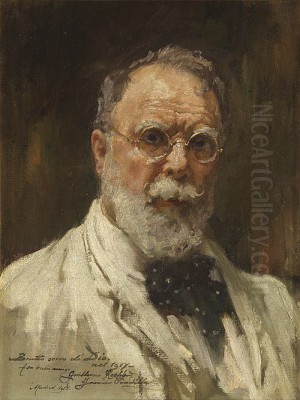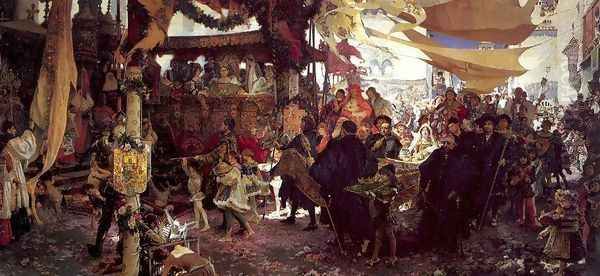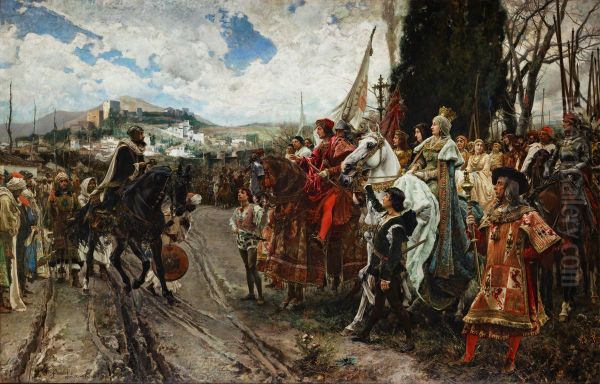
Francisco Pradilla y Ortiz stands as one of Spain's most significant painters of the latter half of the 19th century and the early 20th century. Renowned primarily for his large-scale history paintings, Pradilla possessed a remarkable ability to blend academic precision with dramatic intensity and a keen sensitivity to light and atmosphere. His canvases brought pivotal moments of Spanish history to life with meticulous detail and emotional depth, securing his place not only in the annals of Spanish art but also within the broader European academic tradition. Beyond history, his talents extended to evocative landscapes and intimate genre scenes, showcasing a versatile and evolving artistic vision.
Early Life and Artistic Formation in Spain
Francisco Pradilla y Ortiz was born in 1848 in Villanueva de Gállego, a town in the province of Zaragoza, within the region of Aragon, Spain. His artistic inclinations emerged early, leading him initially to pursue studies in Zaragoza. Like many aspiring artists of his time, he eventually gravitated towards the nation's capital, Madrid, the epicenter of Spanish artistic life and education.
In Madrid, Pradilla enrolled at the prestigious Real Academia de Bellas Artes de San Fernando, the leading institution for artistic training in Spain. This academy had nurtured generations of Spanish masters and provided a rigorous grounding in drawing, composition, and the study of classical principles. He also attended the Academia de Acuarelistas, honing his skills in watercolor, a medium that demands precision and fluidity. His time at these institutions laid the technical foundation for his future career, instilling in him the discipline and draftsmanship characteristic of academic training. Early influences likely included prominent figures associated with the Academy, such as Federico de Madrazo, a dominant force in Spanish portraiture and historical painting.
Financial constraints reportedly marked his early student years, a common challenge for artists lacking independent means or established patronage. However, Pradilla's talent and dedication soon became apparent. His formative years in Zaragoza and Madrid exposed him to the prevailing artistic currents in Spain, which included a strong tradition of historical and religious painting, portraiture, and the burgeoning interest in Costumbrismo – scenes of everyday Spanish life and customs.
The Roman Scholarship: A Gateway to Mastery

A pivotal moment in Pradilla's career arrived in 1873 when he won a coveted scholarship to study at the Spanish Academy in Rome. This institution, housed in the former convent of San Pietro in Montorio, provided Spanish artists with the invaluable opportunity to immerse themselves in the art and culture of Italy, studying classical antiquity and the works of the Renaissance and Baroque masters firsthand. Rome, at this time, was a crucial destination for artists across Europe, a living museum where the foundations of Western art could be absorbed.
During his time in Rome, Pradilla did not confine himself to the city. His scholarship facilitated travels across Italy and beyond. He visited key artistic centers such as Florence, Venice, Pisa, and Milan, where he could study the works of Renaissance giants like Raphael, Michelangelo, Leonardo da Vinci, and the Venetian colorists Titian, Veronese, and Jacopo Tintoretto. The vibrant light, rich colors, and dramatic compositions of the Venetian school, in particular, seem to have left a lasting impression on his developing style.
His travels extended further, taking him to France, including Paris, and several cities in Germany. This exposure to different artistic environments broadened his horizons. In Paris, he would have encountered the dynamic French art scene, including the established academic tradition represented by artists like Jean-Léon Gérôme and the emerging Impressionist movement, although his own work remained largely rooted in academic realism. While in Rome, he also collaborated with fellow Spanish artist and scholar Alejandro Ferrant y Fischermans, indicating his integration into the community of Spanish artists abroad.
Breakthrough: Doña Juana la Loca
The years spent in Rome proved immensely productive and culminated in the creation of the work that would catapult Pradilla to national fame: Doña Juana la Loca (Joanna the Mad). Completed in 1877, this large-scale history painting depicts Joanna of Castile, daughter of the Catholic Monarchs Ferdinand and Isabella, accompanying the coffin of her deceased husband, Philip the Handsome, across the bleak Castilian landscape. The painting is a powerful study in grief, obsession, and psychological turmoil, set against a desolate, windswept backdrop.
Pradilla masterfully captures the queen's profound sorrow and deteriorating mental state, surrounded by her loyal but weary attendants. The composition is dramatic, the figures rendered with realistic precision, and the use of color and light effectively conveys the somber mood and harsh environment. The painting transcends mere historical illustration; it delves into the emotional and psychological depths of its subject, a hallmark of the best 19th-century history painting.

When Doña Juana la Loca was exhibited at the Spanish National Exhibition of Fine Arts in Madrid in 1877, it caused a sensation. It was awarded the Medal of Honor, the highest prize, cementing Pradilla's reputation as a leading history painter of his generation. The work was also shown internationally, including at the Paris Exposition Universelle of 1878, where it received further acclaim. It remains one of the most iconic images in Spanish art history, housed today in the Prado Museum. The success of this painting demonstrated Pradilla's ability to synthesize historical research, technical skill, and profound emotional expression.
The Surrender of Granada: Epic History on Canvas
Following the triumph of Doña Juana la Loca, Pradilla embarked on another ambitious historical subject, commissioned by the Spanish Senate. This resulted in La Rendición de Granada (The Surrender of Granada), completed in 1882. This monumental canvas depicts the moment on January 2, 1492, when Muhammad XII (Boabdil), the last Nasrid ruler of Granada, hands over the keys of the city to the Catholic Monarchs, Isabella I of Castile and Ferdinand II of Aragon, marking the culmination of the Reconquista.
The painting is a complex, multi-figure composition, showcasing Pradilla's skill in organizing large groups of figures and rendering historical costumes, armor, and architectural details with accuracy. The scene is imbued with a sense of historical gravity. Pradilla contrasts the somber dignity of the defeated Boabdil and his retinue with the triumphant yet composed presence of the Spanish monarchs and their court. Figures like Gonzalo Fernández de Córdoba ("El Gran Capitán") are identifiable within the crowd.
Pradilla employs a bright, clear light, characteristic of the Andalusian setting, and a rich palette to bring the scene to life. The landscape and the distant view of the Alhambra add depth and context. Like Doña Juana, The Surrender of Granada was lauded for its technical brilliance and its powerful evocation of a defining moment in Spanish history. It became another cornerstone of 19th-century Spanish history painting and is also housed in the Palacio del Senado in Madrid, confirming Pradilla's status as a painter capable of tackling grand national themes.
Artistic Style: Academicism, Realism, and Light
Francisco Pradilla y Ortiz's style is primarily rooted in Academicism, the tradition emphasizing classical principles of composition, precise drawing, and idealized forms, often applied to historical, mythological, or allegorical subjects. His training at the San Fernando Academy and his studies in Rome reinforced this foundation. His major history paintings, like Doña Juana la Loca and The Surrender of Granada, exhibit the careful structure, detailed finish, and narrative clarity expected of academic works.
However, Pradilla's art is not merely dry academic exercise. He infused his work with elements of Realism, particularly in the convincing portrayal of textures, materials, and human anatomy, as well as the psychological depth he brought to his figures. His characters feel like individuals experiencing real emotions, rather than just archetypes. This realistic impulse is evident not only in his history paintings but also in his genre scenes and portraits.
Furthermore, a subtle Romantic sensibility pervades much of his work, especially in the dramatic intensity of his historical narratives and the atmospheric qualities of his landscapes. His interest in Spanish history and local customs aligns with the Romantic era's fascination with national identity and folklore. Artists like Eugenio Lucas Velázquez, known for his Goya-esque scenes, represented an earlier Spanish Romanticism that Pradilla would have been aware of.
A defining characteristic of Pradilla's style is his mastery of light and color. Influenced perhaps by the Spanish Baroque master Diego Velázquez, as well as the Venetian painters he studied, Pradilla skillfully used light to model form, create atmosphere, and direct the viewer's eye. His palette could range from the somber tones of Doña Juana to the brilliant clarity of The Surrender of Granada or the luminous effects in his landscapes. Some later works show a looser brushstroke and heightened attention to transient light effects, suggesting an awareness of, if not a full conversion to, Impressionism, which was gaining ground during his career, championed in Spain by artists like Joaquín Sorolla.
Landscapes and Genre Scenes: A Broader Canvas
While history painting formed the core of his reputation, Pradilla was also a gifted painter of landscapes and genre scenes. His travels, particularly in Italy, provided ample inspiration for landscapes. Works like Niebla de Primavera en Italia (Spring Mist in Italy, 1907) demonstrate his ability to capture subtle atmospheric conditions and the poetic beauty of nature. These paintings often show a more personal and lyrical side of the artist, away from the demands of large-scale historical narratives.
His landscapes are characterized by a sensitive observation of light, weather, and terrain. He painted scenes from Italy and Spain, often focusing on the interplay between natural elements and human presence, sometimes incorporating small figures or architectural elements. His approach to landscape painting reflects a deep appreciation for the natural world, rendered with the same technical skill evident in his historical works but often with a greater sense of immediacy and freedom.
Pradilla also engaged with genre painting, depicting scenes of everyday life, often with a focus on Spanish regional customs or historical settings. These works allowed him to explore different narratives and character types. His interest in historical detail extended to these smaller scenes, providing glimpses into the past or contemporary life rendered with charm and precision. Works like Flores acuáticas silvestres (Wild Aquatic Flowers, 1904) might blend landscape and genre elements. This diversity highlights his versatility and his continuous exploration of different modes of artistic expression, akin perhaps to the varied output of his contemporary Mariano Fortuny, another Spanish artist who achieved international fame working in Rome and Paris, known for his dazzling technique in historical genre scenes.
Academic Roles, Commissions, and Later Works
Pradilla's success and reputation led to prestigious appointments. He served as the Director of the Spanish Academy in Rome, the very institution that had nurtured his talent years earlier. This position placed him at the head of Spain's foremost artistic outpost abroad, guiding a new generation of Spanish artists studying in Italy. Later, he also held the position of Director of the Prado Museum in Madrid for a period, although administrative duties reportedly proved taxing for him. He also served as a professor at the Real Academia de Bellas Artes de San Fernando, contributing to the education of young artists in his homeland.
Beyond his major public commissions, Pradilla received commissions from private patrons and institutions. He painted murals with historical themes, such as The Baptismal Procession of Prince Don Juan (1910), created for the palace of the Marquises of Linares (though sometimes associated with other locations like Castro Urdiales). These commissions further cemented his status as a painter sought after by the elite for significant decorative and commemorative projects.
His later career saw continued production, though perhaps with less emphasis on the monumental history paintings of his middle period. He continued to explore landscape and genre subjects. Works like Imprisoned Spring (1911) suggest a continued engagement with allegorical or evocative themes derived from nature. Throughout his life, he remained deeply interested in the art of the past, studying and sometimes collecting works by Old Masters, continually seeking to deepen his own understanding and technique. His personal interests extended to literature and history, and he was known to be multilingual, reflecting a broad intellectual curiosity that informed his art.
Connections, Recognition, and Influence
Throughout his career, Pradilla moved within significant artistic circles both in Spain and Italy. His collaboration with Alejandro Ferrant in Rome and his friendship with the influential Italian painter Domenico Morelli (a leading figure in the Neapolitan school known for his historical and religious subjects) highlight his connections within the international art community based in Italy.
His participation in major exhibitions, such as the Spanish National Exhibitions and the Paris Expositions Universelles, brought his work to a wide audience and garnered numerous awards and honors beyond the initial Medal of Honor for Doña Juana la Loca. He gained recognition from fellow artists, critics, and collectors. His works were sought after by patrons like the Spanish entrepreneur Agustín Peiró y Seil, who became both a collector and a friend. Connections with dealers in Germany and galleries in Paris helped to promote his work internationally, making him one of the Spanish artists with a significant reputation abroad during his lifetime.
As an educator at the San Fernando Academy and Director in Rome, Pradilla undoubtedly influenced younger Spanish artists, transmitting the principles of academic training while also embodying the potential for achieving national and international success through history painting and other genres. He worked during a period of transition in Spanish art, bridging the gap between the mid-19th-century historical Romanticism of painters like Eduardo Rosales and the turn-of-the-century modernism and Luminism exemplified by Sorolla.
Legacy: A Pillar of Spanish Art
Francisco Pradilla y Ortiz passed away in Madrid in 1921 at the age of 73. He left behind a substantial body of work that secured his legacy as one of the preeminent Spanish painters of his era. His fame rests primarily on his masterful history paintings, which not only documented pivotal moments in Spain's past but did so with a technical virtuosity, dramatic flair, and psychological insight that resonated deeply with his contemporaries.
His works continue to be celebrated for their meticulous detail, strong compositions, and skillful handling of light and color. Doña Juana la Loca and The Surrender of Granada remain iconic representations of Spanish history painting and are major highlights of the collections they belong to (Prado Museum and Spanish Senate, respectively). Many of his other works, including landscapes, genre scenes, and studies, are housed in the Prado Museum, the Museo de Zaragoza, and other important public and private collections in Spain and abroad.
Pradilla y Ortiz represents the pinnacle of academic history painting in Spain during the late 19th century. While artistic tastes shifted towards Modernism in the early 20th century, leading to a temporary decline in the appreciation of academic art, recent scholarship has re-evaluated the contributions of artists like Pradilla, recognizing their technical mastery and their role in reflecting and shaping national identity through art. He remains a key figure for understanding the artistic landscape of Spain during a period of significant cultural and political change, a chronicler of its history, and a master of his craft.